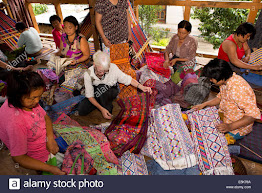Weaving-. An art form in bhutan
In Bhutan, every region has its own specialty. For example, bura (raw silk) is popular in Trashigang. In kurtoe or lhuntse , sesho (fine silk) is very widely used. And of course, yathra is the trade mark of bumthang and western parts of the country. What makes them special is that all the weavers in Bhutan are women.
Come winter, and the village of khoma in kurtoe, lhuntse reverberates with the sound of the wodden beater hitting the wrap as women weave the famous kishuthara.
Kishuthara is special in that the silk patterns are one of the most colourful and intricately woven bhutanese fabrics in the country. It's origins go back several centuries and each kishuthara has the signature of it's Weaver who designs patterns depending on the occasion that kishuthara is to be worn at as on ocassions grown in importance, so do the intricacy and denseness of the patterns.
It is a common sight, especially after the harvest season in khoma, to find women in groups of six to ten sitting upright in rows with their back strap looms, sheltered by bamboo canopies, in the harvested paddy fields weaving. The youngest Weaver in the group could be anywhere between eight to ten years old such is the demand for kishuthara in Bhutan that the skills have been passed down from one generation to another.
As beginners the young girls, learn to weave on cotton fabrics using silk threads for the intricate designs, seated beside the watchful eyes of their mothers. A gho or Kira of the kishuthara fame can catch the Weaver anything from NU 40,000 to 75,000. Learning to weave a kishuthara is not easy. There are a number of procedures involved before weavers can finally get started. They have to first learn to boil the silk in a cirtric mixture to retrain the original colour of the silk, before drying in the sun. The dry silk is then spun into a ball to form a continuous yarn which is staretched on two strands before it is finally spread out vertically on the loom.



It's beautiful
ReplyDelete